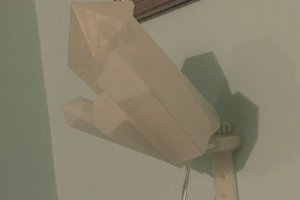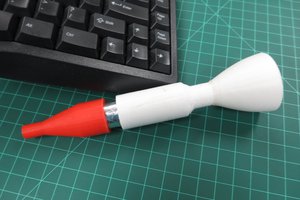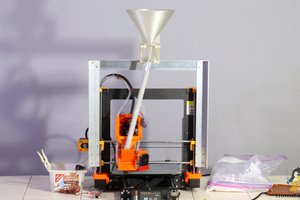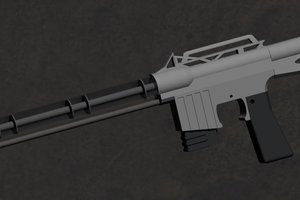I had thought about the solution, but took no action. Then, one day, they asked me to change the batteries in the electronic portion of the lock. While I was there, I also took off the lever and grabbed some quick measurements with a ruler they had in the house and used a sharpie to jot them down on a piece of floral notepad.
I went back to the shop, opened up Fusion 360, and designed a short version of the extension to test to test the basic fit. I wasn't sure the "free advertisement" ruler would give me accurate dimensions and I worried about the tolerances for real world use. But the design seemed simple enough. Just a sleeve with matching male and female parts.
But the lockset is made out of metal. So when I started looking at the dimensions I realized the 1mm thick walls would not be strong enough on a 3d print. I thickened walls wherever I could. The result does give a slightly bulging look to the print, but it looks good enough to use. I even thought about adding a bell or flare to the thin walled area of the female socket, but didn't because I didn't want to force an aesthetic change onto the elderly couple.
The next time I visited the neighbors, I took my calipers and the test print. Surprisingly, the dimensions were "close enough" to work. But the calipers helped me dial in the fit even more.
However, I had not noticed some subtle sloping and fillets. So the partial prints really helped get the fit correct before I wasted a lot of plastic and time.
I used the new, more accurate dimensions and printed out a full version of the tube. There are still some spots that look odd to me, like the location of the set-screw hole, but it works so I stopped designing.
When I printed it I upped the number of walls, used every interlocking and overlapping slicer setting I know about to increase layer adhesion and printed with a high infill percentage. Then I negated all the work by becoming impatient and printing quickly with thick layers. I really expected to be working and printing several more iterations so I thought I would have time to dial in the print for maximum strength. However, this was the final print, and it's in basic low-cost PLA.
I took the extension tube back to the neighbors and installed it. The tube worked great but I know it has some problems, and will have more as time and seasons change.
The color and finish need help. I offered to buy some mottled-nickel spray paint but wouldn't guarantee the durability or appearance. The neighbors declined.
I also worried about the durability of the tube. I printed the tube fast and loose, so the layer adhesion might not be the best. With severe forces in tension, torsion and bending I really worried about it snapping off. The length of the tube and the handle itself just increase those forces.
Usually, I can overcome such issues by correctly orienting the print on the bed. But with this project there didn't appear to be any good at, or best way, to orient the print. There are forces acting to split the body on its longest axis, to sheer the tube around the circumference and even pulling straight up between the layers. It was going to be weak in some way no matter what, so I just printed it vertically.
I even posted in a forum asking for tips on increasing the strength. Several people had wonderful suggestions - everything from wrapping it and resin coating, to metal rod inserts to flooding the infill regions with resin. Of course the best solution was to purchase the metal version that's already being manufactured.
Having me take apart their door lock several times in one week was enough for the neighbors. I was told not to do any more designs or tests or improvements. It worked and that's all they cared about. So the beta test went live.
Well.. the quickly printed, cheap PLA extension tube survived the summer with no failure or even minor cracking, so I deem it a success. However, I took it off before the winter set in. The...
Read more »

 PointyOintment
PointyOintment
 Norbert Heinz
Norbert Heinz